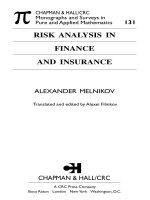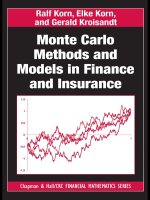Numerical Methods in Finance and Economics A MATLAB-Based Introduction_3 potx
Bạn đang xem bản rút gọn của tài liệu. Xem và tải ngay bản đầy đủ của tài liệu tại đây (240.35 KB, 20 trang )
This page is intentionally blank
A
S ADVISERS STRIVE to build closer relationships with their clients
and improve the quality of their services, more firms have begun
to formalize their approach to gathering feedback from clients. For
advisory firms developing and refining their business strategy, we’ve
found client surveys to be invaluable because they help the firms get
in tune with their market and with the services the optimal client
looks to them to provide.
For many years, we were skeptical about the value of client surveys
because we did not believe that eliciting satisfaction scores from cli-
ents would garner anything particularly insightful. It seemed unlike-
ly that clients who disliked an adviser would respond, and those that
had “warm and fuzzy” feelings about their advisers would probably
sugarcoat their responses. The validity and real value of the client
surveys was always suspect to us.
Then we found a survey process that not only allowed clients to
evaluate their advisers in a meaningful way but also could be used
as a tool to allow clients to identify their needs and preferences in
adviser-client communication and the planning areas they wish
advisers would address with them. Advisers who participated in such
surveys were generally surprised by the results because in many cases
they thought they had broached these subjects with their clients, but
the overtures had not always registered. Ross Levin, of Accredited
Investors, for example, tested a tool developed by Advisor Impact
of Toronto. “Our results were positive, and yet some of the specific
points were surprising,” he says. “Some clients wanted to meet less
39
KNOWING
YOUR
CLIENTS
The Value of Surveys
3.
40 PRACTICE MADE PERFECT
often than we currently do. Also, some clients wanted more general
communication. After the survey, we worked with our staff to deter-
mine optimum meeting schedules. We also now send out a regular
e-mail update on our views on the market, interest rates, and other
relevant data.”
Hear No Evil
Despite the potential for such enhancements, only about a third of
advisers have surveyed their clients in the last twelve months, accord-
ing to research by Advisor Impact. And although some advisers point
to a lack of time or expertise as the primary obstacles to conducting
a survey, the fear factor tends to top the list of self-imposed barriers.
Some advisers are afraid to hear what their clients will say—a concern
present in both good and bad markets. But research doesn’t support
the fear factor. Theoretically, in a market as competitive as financial
services, existing customers on average tend to be highly satisfied
or else they would leave. Our research confirms that argument in
practical terms.
As part of a joint venture between Advisor Impact and Moss
Adams LLP, we surveyed more than ten thousand clients on behalf
of financial advisers across North America. No adviser got an over-
all satisfaction rating lower than four out of a top score of five. Yet
that process also revealed that between 2 percent and 10 percent
of clients are, in fact, at risk of defecting. This is a very disturb-
ing percentage considering how many advisers believe their clients
are perfectly content. Surveys done in Canada, the United States,
and Australia all have identified “managing client expectations” as
among the top sources of anxiety for financial advisers. With so
many things competing for your time, it’s helpful to find efficient
tools that allow you to probe these expectations. What’s more, in
an environment where competition is intensifying and the offer-
ings from banks, CPAs, law firms, and other wealth managers are
becoming more responsive, client surveys are a vital intelligence-
gathering tool. Your practice may not be geared toward “cross
selling” in the traditional sense of a bank or brokerage firm, but
retaining clients is a form of selling that every professional adviser
KNOWING YOUR CLIENTS: THE VALUE OF SURVEYS 41
must be conscious of. Clearly, a client survey can provide insight
beyond what can be gained from regular client contact, because it
allows the person to respond without being confronted or having
to look the adviser in the eye.
For most advisory firms, more than 85 percent of revenue comes
from existing clients. So it’s ironic that advisers tend to spend more
money on new business development than they do on harvesting
and maintaining the relationships they already have. In fact, even
compensation plans are geared toward getting more clients rather
than retaining or deepening the relationship or share of wallet with
current clients.
Client surveys can improve overall client profitability. Properly
structured, surveys improve the efficiency, loyalty, time management,
and productivity of your professional staff. Systematically uncovering
issues through a survey process not only helps you manage costs bet-
ter; it also makes your practice better able to attract assets, drive rev-
enue, introduce value-added services, and elicit referrals from your
client base (see Figure 3.1).
A comprehensive study published in the Harvard Business
Review
1
in 2002 reached some strong conclusions in favor of survey-
FIGURE 3.1 Improving Client Profitability
Efficiency Assets under
management
Referrals
Product/service
RevenueLoyalty
Time
Direct costs
Costs Revenue
CLIENT
PROFITABILITY
Source: © Advisor Impact
42 PRACTICE MADE PERFECT
ing clients. The study found that clients surveyed for a large financial
institution were more than three times as likely to have opened new
accounts, half as likely to have defected, and were more profitable for
the firm than clients who were not surveyed. The study noted that
these results, which peaked after three months, extended for up to
twelve months after the survey.
At least two factors explain these results. First, surveys remind
clients that they appreciate the services you offer. In general, cli-
ents are unlikely to have spontaneous positive thoughts about you
unless reminded or asked explicitly. Second, by asking clients ques-
tions about specific services, you increase their awareness of those
offerings.
A properly performed client survey will uncover the following:
! Satisfaction
! Expectations
! Preferences
! Interests
! Referral propensity
! Your share of wallet
! Client profile
Such insights enhance your value to clients and their value to
you.
How to Elicit Constructive Responses
There are three ways to elicit responses from clients: take an ad hoc
approach and ask them for comments at the end of a meeting, con-
duct a telephone survey, or conduct a written survey. To decide which
route to take, you’ll need to weigh the costs of the program against
the depth of information you’ll receive and the extent to which
answers are provided honestly. In general, written surveys tend to be
the best option. Although more expensive, they let you ask a large
number of questions, give clients time to respond thoughtfully, and
offer clients the option of anonymity.
It can be difficult to directly compare the cost of outsourcing
the survey process to the cost of doing it in-house, but you’ll typi-
KNOWING YOUR CLIENTS: THE VALUE OF SURVEYS 43
cally spend more time and money if you conduct the survey on your
own. To create a professional survey instrument with well-designed
questions that will yield the insights you seek, you’ll likely need to
hire a writer and possibly a graphic designer to prepare the question-
naire and then pay for printing and mailing the survey, entering the
response data, and analyzing the results. Advisor Impact’s Client
Audit process, for example, would cost around $2,000 plus out-
bound postage to survey two hundred households, with an expected
30 percent response rate, but a similar effort done in-house could
cost a planner more than twice that amount and likely yield less
meaningful results.
Using professional organizations such as Dalbar, Advisor Impact,
or local marketing firms tends to enhance the survey process. It’s like
an individual who prefers to make planning, investment, and risk-
management decisions without seeking qualified advice. She can do
it cheaper, but can she do it better? We find that advisers who try to
do surveys themselves either do not get them finished or have dif-
ficulty interpreting the results. Worse yet, they skew the results by
asking the wrong questions, or they skew the wording of the ques-
tions to get the answers they want to hear.
For the do-it-yourselfer, the first challenge is identifying which
questions to ask clients. To start, think beyond “satisfaction.”
A properly structured survey helps you uncover client expectations,
identify cross-selling and consolidation opportunities, pinpoint
those clients who are willing to provide referrals, and gather valu-
able intelligence about any current or planned communications or
activities. For the best results, be sure to ask questions in five spe-
cific categories:
1. Focus on service satisfaction, both generally and specifically.
2. Probe client expectations regarding contact level.
3. Assess interest in learning about different products and services.
4. Determine client preferences about how you communicate.
5. Ask for profile information to help you populate your data-
base.
Even if you cover all of your bases, not all questions are equally
effective. Good questions provide you with specific and targeted
44 PRACTICE MADE PERFECT
information. Bad questions are vague, are difficult to understand, or
lead to client responses that are difficult to interpret. (See Figure 3.2
for examples of good questions in each category.) For every question
in a survey, you should know what you’ll do with the results. If you
do not control client statements at your firm, for example, do not ask
about satisfaction with client statements on the survey.
If you do go it alone, the process of surveying clients can be oner-
ous but rewarding. Given the investment of time and money, make
sure you fully exploit the results. You can get the biggest bang for
your buck by
FIGURE 3.2 What to Ask and How to Ask It
Sample Question Tips and Comments
Satisfaction My calls are returned Be specific about the
promptly (on a five-point elements of client service
scale from “completely rather than asking vague
agree“ to “completely questions about service
disagree”). in general.
Expectations How many times do you Gather quantitative data
expect to meet in a 12- when possible.
month period to review
your financial plan?
Interests Which of the following Get clients thinking about
are you interested in the services you provide;
learning more about? don’t leave too many
(Provide list of services.) open-ended questions.
Preferences Do you think it’s important Don’t just ask how you
for your financial adviser are doing; find out what
to provide educational is most important to your
opportunities? clients.
Profile What is your e-mail Gather better information
address? to populate your database.
KNOWING YOUR CLIENTS: THE VALUE OF SURVEYS 45
! sending a follow-up letter to all clients, highlighting positive
feedback and identifying any changes you plan to make as a
result of the survey
! surveying clients every eighteen months and tracking your
progress
! summarizing your results for centers of influence and prospects
Testimonials are helpful, but research data are seen as more
objective.
In the spirit of full disclosure, we mention here that Moss Adams
LLP adopted the Client Audit process for its advisory-firm clients
after evaluating many options. By using a proven survey process—in
this case, one developed by Advisor Impact—we’ve consistently been
better able to develop insight into how our advisory-firm clients
should be thinking strategically about their businesses.
The Client Audit process is a structured approach that provides
a customized solution. The survey form is customized and then
provided to the adviser for mailing to clients, and the reports are
returned to a central processing center. There, the data are evaluated
and interpreted and action steps are developed for the adviser (see
Figure 3.3 on the following page).
In addition to the insight, what’s compelling about this process is
the action plan that comes out of the survey. So many times, when
surveys are performed, clients are often left wondering what the pur-
pose or result was. So regardless of whether you do it on your own
or in concert with a professional survey firm, you’ll want to translate
the survey results into an action step or the process will be wasted,
along with the money it cost to do it.
“Since surveying our clients, we’ve developed a sharper pic-
ture of our strengths,” says Jennifer Hatch, an adviser with
Christopher Street Financial in New York. “We understand our
weaknesses and can respond before our clients decide to bail.
For example, we were able to understand the level of service that
each of our advisers was providing and discovered that [it] varied
drastically. As a result, we now set an explicit service standard for
everyone in the company.”
46 PRACTICE MADE PERFECT
Proceed with Caution
You need to be aware of some restrictions regarding how to conduct
surveys and how to use the information gathered. The American
Marketing Association has a clear code of ethics regarding marketing
research, including satisfaction surveys, and that code was written
into law. You cannot sell services to clients under the guise of con-
ducting research. Therefore, if you plan to ask questions about client
needs and then use that information to follow up with them, make
your intentions clear in the cover letter and reiterate that the client
may respond anonymously.
FIGURE 3.3 The Report
Your
Client
Audit
Report
Action Plan
✓
Follow-up templates for clients, centers of influence,
and prospects
!
Suggested client marketing campaigns
!
Assessment and identification of assets at risk
✓
Recommended changes to service structure
The Big Picture
✓
Overview of all responses, including:
!
Key marketing opportunities
!
Top client issues
✓
Client expectations regarding contact and education
Client Opportunity Report
✓
Client-by-client overview of key opportunities
!
Cross selling
!
Consolidation
!
Referrals
!
Other marketing opportunities
✓
Follow-up lists for key marketing opportunities
Source: © Advisor Impact
KNOWING YOUR CLIENTS: THE VALUE OF SURVEYS 47
Overall, the best way to make a client survey successful is to
! keep it short
! assess importance and performance
! ask actionable questions
! include a deadline
! provide an incentive
! make including client’s name optional
! code the surveys (to maintain anonymity)
! include an open-ended question
! make it easy to respond
Client Surveys and the Bottom Line
Many advisers consider client surveys a way to let clients know that
they care. They do, in fact, demonstrate a real commitment to client
relationships (provided you follow up on the results), but they can
do much more.
Our premise throughout this book is that the work of advisers
profoundly affects the lives of their clients. An adviser’s work gives
peace of mind, clears the road to financial independence, and helps
individuals and families to manage their risks. Yet many advisers do
not have the confidence to ask for fair compensation for the value
they provide.
A hidden benefit of the client-survey process is that it allows
you to listen and respond constructively to clients in ways that will
enhance your value. The survey can provide the psychic gratification
of anticipating client needs. But it can also further demonstrate your
value to your clients and justify your fees in a way that helps you to
be profitable and fairly rewarded for what you provide.
Note
1. Paul M. Kholakia and Vicki G. Morwitz, “How Surveys Influence
Customers,” Harvard Business Review (2002): 18–19.
This page is intentionally blank
S
INCE THE EMERGENCE of the independent financial adviser in
the 1970s, many practitioners in this business have characterized
themselves as entrepreneurs. Since they’re no longer employees of
a parent organization, the notion is that they are, in fact, business
owners. They have the same risks and responsibilities as those who
leave the cocoon of an employer-based organization and begin their
own enterprise. In reality, many of these financial advisers are not
entrepreneurs; they are simply self-employed. What’s the difference?
Entrepreneurs start a business and build it into an organization
that invests in people, systems, and branding. Self-employed advis-
ers, on the other hand, consider themselves employees of their own
business, not investors in that business. These firms are operated by
individuals who avoid putting money into their business, respond
and react to opportunity, and consciously limit growth primarily
because they have an aversion or fear of working with other people.
That’s not to say one approach is better than the other; it’s a fork in
the road. The right path to take depends on each individual’s per-
sonal definition of success.
Is this debate merely verbal fencing? Not entirely. By committing
to being true entrepreneurs, advisers make a conscious decision to
invest in infrastructure that allows them to leverage off of other peo-
ple, systems, and processes. In other words, they commit to building
an enterprise that is not totally dependent on its owner.
That said, the solo practitioner operating simply as someone self-
employed is hardly a dead concept. On the contrary, solo practitio-
49
BUILDING
LEVERAGE
AND
CAPACITY
The Challenge of Growth
4.
50 PRACTICE MADE PERFECT
ners today represent the vast majority of financial advisers and will
likely continue to do so. Whether they’re operating within a large
brokerage house or bank or out of a guest bedroom or garage, many
people in this business prefer to work alone rather than be part of a
team. Going solo is a lifestyle choice that has merit. These advisers
have independence, freedom from having to manage others, and the
ability to do as they please without needing anyone else’s consent.
But the limitations in this model are apparent when you attempt to
resolve the competing issues of providing better service to demand-
ing clients, getting access to expertise beyond your own, having the
capacity to grow, living a balanced life, and achieving financial inde-
pendence separate from the business.
The Entrepreneurial Crossroads
The profession is at a crossroads. Will individual practitioners opt for
independence rather than depth? Will they struggle to serve clients
and grow? Will they be able to respond to the growing need to invest
in technology? How dependent will they become on their broker-
dealers or custodians to help them build infrastructure? How will
this dependence change the economics of their businesses?
Most financial-advisory firms are in that awkward adolescent
state. They’re too big, yet they’re too small. Once an advisory firm
begins to add any staff, it has started to accelerate its growth. It
will need to monitor and measure performance, coach and counsel
people, produce an increasing amount of revenue to cover the added
overhead, and invest in more technology solutions, office space, and
employee benefits. The joy ride begins, with the owner careening
around corners and into dead ends—one foot on the accelerator, the
other on the brake.
But most practitioners are consumed by the daily grind. Do you
really want to build a business, or would you rather narrow your
focus to deal with a few select clients? Although it may be intuitively
appealing not to expand your practice so as to avoid the associated
headaches, the reality is that every practice will experience problems
in each of the management areas much of the time. If you choose not
to grow, then you do not provide a career path for the outstanding
BUILDING LEVERAGE AND CAPACITY: THE CHALLENGE OF GROWTH 51
individuals you hire, which may cause them to leave and in turn force
you to hunt for talent again. You may also find it hard to produce
sufficient cash flow and profits to reinvest in your business in a way
that will help you serve your clients better. And by staying small, you
preempt one of the best options for succession. Although you may not
be at the point where you’re concerned about succession, you can be
sure that your clients are. It’s likely they’ve developed some depen-
dence on you, and they surely want to know what will happen to them
if something happens to you. Whichever path you choose—growth
or no growth—your challenge will always be to provide service and
fulfillment to your clients while maintaining an adequate level of
income, life balance, and peace of mind in your practice.
Vital Signs
The most successful advisory firms have several common charac-
teristics:
! Clear vision and positioning
! Human capital aligned with their vision
! A compensation plan that reinforces their strategy
! A conscious attitude about profit management
! A process of systematic client feedback
! Built-in leverage and capacity
These concepts apply whether you’re a one-person operation or
ensemble practice. The difference in the two operating models is
that as a solo practitioner, you are the only adviser; in an ensemble
model, other advisers or professional staff are a critical part of your
practice. We believe that the concepts of strategy, financial manage-
ment, staffing, and client feedback are relevant and meaningful to
solo practitioners, but it has become clear to us that the one thing
solo firms lack is the built-in leverage and capacity that distinguishes
the elite ensemble firms.
A few years ago, we were asked to look at the team-based plat-
form of a wirehouse that was attempting to move away from the indi-
vidual-producer model that has always been the operating approach
of both insurance and stockbrokerage firms. We were impressed
that the teams within this firm were generating more income per
52 PRACTICE MADE PERFECT
adviser and more income per client and seemed to be eliciting higher
client-satisfaction scores than their individual-producer counter-
parts. Granted, this observation had no statistical validity because of
the small sample, but it intrigued us enough to examine how inde-
pendent firms compared.
We sliced the data from our benchmarking studies produced in
partnership with the Financial Planning Association (FPA) to evalu-
ate the operating performance of solo practitioners versus ensemble
firms. Size did matter among the general population of advisers who
opted to become ensemble businesses, meaning they had multiple
principals, partners, or professionals (nonowner advisers). The gap
was especially startling when we compared the top-performing solo
practices with the top-performing ensemble practices. The top-
performing ensembles generated almost 20 percent more revenue per
professional, nearly twice the revenue per client, and about two times
the take-home income per owner than their top-performing solo
counterparts (see Figures 4.1–4.4).
During the many years of this research, we’ve continued to
observe a gap of some magnitude in key ratios between the two
platforms. Anecdotally, advisers who’ve made the transformation to
FIGURE 4.1 Ensemble Firms Are More Productive
Revenue per StaffRevenue per Professional
Solos
Ensembles
Dollars
$420,396
$174,938
$500,000
$191,824
0
100,000
200,000
300,000
400,000
500,000
600,000
Source:
FPA Compensation and Staffing Study
, High-Profit Solo and
Ensemble Firms, © Moss Adams LLP
BUILDING LEVERAGE AND CAPACITY: THE CHALLENGE OF GROWTH 53
the ensemble model tell us that they’re more responsive and more
proactive in dealing with their clients, which makes sense. In the
traditional solo model, the challenge for the adviser is that he or she
FIGURE 4.2 Ensemble Firms Reward Their Owners
0
100,000
200,000
300,000
400,000
500,000
600,000
700,000
800,000
1,000,000
Annual Median Take-Home Income per Owner
Solos
$384,900
Ensembles
$762,287
Dollars
FIGURE 4.3 Annual Median Revenue per Client
$2,269
$1,399
$8,456
$6,938
1 Principal
2 Principals
3 Principals
4 Principals
Source: © Moss Adams LLP
Source: FPA Compensation and Staffing Study
, High-Profit Solo and Ensemble Firms
54 PRACTICE MADE PERFECT
is the only one who can give advice, generate new clients, and man-
age the business. Of course, the administrative staff can support the
single owner—and many do so quite well—but they usually do not
have the licenses, credentials, interest, skill sets, or qualifications to
do what the adviser does (see Figure 4.1).
The Limits of Efficiency
For the solo model, an even more daunting problem relates to
profitability: The more clients the firm acquires, the more it needs
to add administrative staff to support them. True, certain technol-
ogy solutions can improve efficiency—see Virtual-Office Tools for
a High-Margin Practice by David Drucker and Joel Bruckenstein
(Bloomberg Press, 2002)—but eventually a practice needs admin-
istrative people to deal with the clients. That’s what makes this a
people business.
When a firm adds administrative staff (this includes management,
support staff, and others involved behind the scenes), the cost is
charged to overhead expense. In other words, the addition of admin-
istrative staff adds nothing to productive capacity. Overhead costs go
FIGURE 4.4 Broader and Deeper Client Relationships
Dollars
0
1,000
2,000
3,000
4,000
5,000
6,000
Annual Median Revenue per Client
Impact
!
More affluent clients
!
More products/services
per client
!
More client touches
!
Bigger market presence
!
More time available
$2,634
Solos
$5,708
Ensembles
Source: FPA Compensation and Staffing Study
, High-Profit Solo and Ensemble Firms
BUILDING LEVERAGE AND CAPACITY: THE CHALLENGE OF GROWTH 55
up while the firm is at a physical limit in terms of how much new
business it can take on, because the owner-adviser can manage only
a finite number of relationships.
It’s becoming more apparent that at least in terms of cost, the level
of volume that must be generated in an advisory practice is redefining
“critical mass.” Critical mass in this context is the point at which a
firm is achieving optimal efficiency in its cost structure, optimal prof-
itability based on its client-service model, and optimal effectiveness in
the number of clients it can serve well. In terms of effectiveness, the
less time an adviser spends dealing with clients, the more sluggish the
business becomes and the less valued it is by the clients themselves. In
terms of efficiency, advisory firms would ideally keep their overhead
costs as a percentage of revenue below 35 percent.
In Figure 4.5, we observe what happens to costs as a percent-
age of revenue as practices grow larger. The data from a study
we did of financial-advisory practices for the Financial Planning
Association in 2004 shows that expenses as a percentage of revenue
actually increased as the firms generated more revenue, peaking
at an expense ratio of 44 percent when practices hit $1 million in
revenue. The expense ratio declined after that point, as practices
FIGURE 4.5 Economies of Scale
Percentage
<$250K $250K–
$500K
$500K–
$1M
$1M–
$2M
$2M–
$3M
$3M–
$5M
>$5M
Support/Admin salaries
Total overhead
0
10
20
30
40
50
42%
42%
44%
41%
36%
35%
38%
Source:
FPA Compensation and Staffing Study
, High-Profit Solo and
Ensemble Firms
56 PRACTICE MADE PERFECT
became more efficient and added more productive capacity in the
form of professional staff. But it isn’t until practices hit $5 mil-
lion of annual revenue that they consistently achieve the optimal
expense ratio of 35 percent.
Part of this assessment is obviously theoretical—and, in fact, a
flight of fancy for many advisory firms that will never achieve or
aspire to a practice this size. But at one time, $1 million of revenue
and $100 million of assets under management were considered the
ultimate achievement. Now it appears that $5 million is the new level
of critical mass for an advisory firm. The challenge is to determine
how many clients, generating how much in fees, served by how many
advisers will a firm need to achieve critical mass by this definition?
And what are the implications for the client-service approach and for
the infrastructure if the practice grows to this size?
Time Well Spent?
Julie Littlechild at Advisor Impact offers a way to come up with an
answer to this question. Littlechild examined how much time a typi-
cal adviser spends serving high-priority clients, average clients, and
low-priority clients. Figure 4.6 shows that advisers clearly max out in
terms of the number of optimal relationships they can manage. Let’s
look at the time spent serving the high-priority clients.
In this example, an adviser estimates he has eleven proactive
contacts with each high-priority client in a year—three face-to-
face meetings and eight by phone. Each of these meetings requires
some preparation. The adviser also consumes a fair amount of time
responding to client inquiries, which often involve some research as
well. The total time spent dealing with a high-priority client is esti-
mated at 19.8 hours per year. For the sake of simplicity, let’s round
this to twenty hours.
The typical adviser puts in 1,800 hours in an average work year—
some work more, some less. By dividing twenty hours into 1,800, it
would appear that the maximum number of high-priority clients the
adviser can manage is ninety. And that’s assuming the adviser does
nothing else and that he has only top-priority clients. Of course,
that’s never the case, which makes this exercise all the more painful
for advisers who have no way to leverage.
BUILDING LEVERAGE AND CAPACITY: THE CHALLENGE OF GROWTH 57
What if the adviser added associate-level professional staff who
could handle client meetings and respond to client needs and were
properly trained and licensed to provide advice? What if he invested
in technology and other tools that would allow him to leverage bet-
ter? Would these changes allow him to grow more profitably and be
even more responsive to client issues?
Assuming the adviser has already implemented technology solu-
tions to become very efficient, he now has few methods by which to
grow the firm’s income: cull the clients to remove the ones at the
bottom and take on only the more profitable relationships, limit the
number of clients the firm takes on so that he can keep the admin-
istrative staff at a manageable size, or raise his fees. If he does any of
these things, he probably can preserve the firm’s size and maintain
his span of control over a key number of client relationships. But
advisers typically do not recognize that they’re drowning in oppor-
tunity until they’re overwhelmed. None of these remedies directly
addresses the client-service problems he may have created by grow-
ing beyond his ability to provide clients with good service, but these
steps can at least keep relationship management within reach.
Each of these choices is reasonable, but they’re likely to go against
the grain for advisers who thrive on new clients or those who feel
an obligation to respond to their sources of referral when new busi-
ness opportunities come in. This point was brought home to us in a
study group of ten advisers. Twice a year, they would meet to share
successes and challenges, compare their firms’ numbers and ratios,
and take turns making presentations on new initiatives. At one of the
meetings, one adviser was adamant that he had no desire to grow his
firm beyond its present size. “Look,” he said, “I make a good liv-
FIGURE 4.6 Contact Goal: Senior Adviser
Face to Face Telephone Proactive Contacts/Year
Top-Priority Clients 3 8 11
Average Clients 2 4 6
Low-Priority Clients 1 2 3
Source: © Advisor Impact









